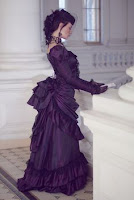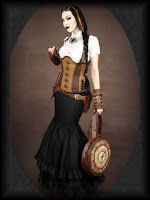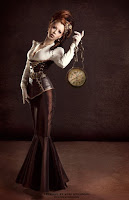Here's a brief explanation of the evolving skirt styles during the Victorian period:
- 1830s - Women wore long full skirts with layers of horsehair petticoats to create a bell shape
- 1840s - Skirts lengthened and widened due to the invention of the horsehair crinoline. Ruffles, flounces and other decorative accents gained popularity.
- 1850s - Skirts widened and expanded with the invention of cage crinoline, a large hoop structure that eliminated the need for layers of petticoats. Ruffles and flounce remained in fashion.
- 1860s - Crinolines flattened in front and expanded in back as long trains become popular. The bustle became the ideal way to create the same silhouette.
- 1870s - The tournure (a cage bustle worn at the back of the skirt) and draped overskirts created an exaggerated rear, resulting in the "big butt" trend of the Victorian era (what women resorted to before fat injections and butt implants were invented).
- 1880s - As women started living more active lifestyles, large bustles and draped skirts began falling out of fashion.
- 1890s - Bustles and petticoats were ditched altogether. Skirts flared out naturally from the waist. Toward the end of the decade, they tightened around the hips and flared out mid-thigh.
- 1900s - Skirts eventually narrowed and tightened all the way down to the knee before flaring out.
All of these Victorian skirt styles and their modern, sexier incarnations provide women with a wide variety of skirt and dress shapes to choose from.
Learn more about the skirt and dress styles commonly worn in Steampunk fashion:
 BELL SKIRT (1830-1870)
BELL SKIRT (1830-1870)TIERED/FLOUNCE/RUFFLE SKIRT (1840-1880)
CAGE SKIRT (1860s)
BUSTLE SKIRT (1860-1890)
HIGH-LOW HEM/POLONAISE (1870-1890)
TRUMPET SKIRT (1890-1900)
SHOWGIRL SKIRT (1890-1900s)
MERMAID/FISHTAIL SKIRT (1900-1910)
FOR MORE:
In Part 1 of the Guide, everything you ever wanted to know about corsets. Underbust, overbust, longline and waspies--how Victorian era corsets have influenced Steampunk Fashion: Corsets
Learn how to recreate popular Steampunk costumes: Tutorials
Browse our carefully curated photo gallery of beautiful Steampunk cosplayers: Fashion Inspiration








No comments:
Post a Comment
Note: Only a member of this blog may post a comment.